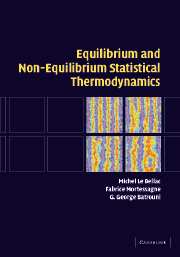Book contents
- Frontmatter
- Contents
- Preface
- 1 Thermostatics
- 2 Statistical entropy and Boltzmann distribution
- 3 Canonical and grand canonical ensembles: applications
- 4 Critical phenomena
- 5 Quantum statistics
- 6 Irreversible processes: macroscopic theory
- 7 Numerical simulations
- 8 Irreversible processes: kinetic theory
- 9 Topics in non-equilibrium statistical mechanics
- Appendix
- References
- Index
4 - Critical phenomena
Published online by Cambridge University Press: 03 December 2009
- Frontmatter
- Contents
- Preface
- 1 Thermostatics
- 2 Statistical entropy and Boltzmann distribution
- 3 Canonical and grand canonical ensembles: applications
- 4 Critical phenomena
- 5 Quantum statistics
- 6 Irreversible processes: macroscopic theory
- 7 Numerical simulations
- 8 Irreversible processes: kinetic theory
- 9 Topics in non-equilibrium statistical mechanics
- Appendix
- References
- Index
Summary
In Chapter 3, we examined two examples of phase transitions, the paramagnetic–ferromagnetic transition (Section 3.1.4) and the liquid–vapour transition (Section 3.5.4). In the latter case, thermodynamic functions such as entropy or specific volume are discontinuous at the transition. When, for example, one varies the temperature T at constant pressure, the transition takes place at a temperature Tc where the Gibbs potentials of the two phases are equal, but the two phases coexist at Tc and are either stable or metastable in the vicinity of Tc. Each of the phases carries with it its own entropy, specific volume, etc., which are in general different at T = Tc, hence the discontinuities. Such a phase transition is called a first order phase transition. The picture is quite different in the paramagnetic–ferromagnetic phase transition: the thermodynamic quantities are continuous at the transition, the transition is not linked to the crossing of two thermodynamic potentials and one never observes metastability. Such a transition is called a second order, or continuous, phase transition. The transition temperature is called the critical temperature and is denoted by Tc.
The new and remarkable feature which we shall encounter in continuous phase transitions is the existence of cooperative phenomena. To be specific, think of a spin system, for example an Ising or a Heisenberg model, where the interactions between spins are limited to nearest neighbours. More generally we shall consider short range interactions, which decrease rapidly as a function of the distance between spins, and we exclude from our study all long range interactions.
- Type
- Chapter
- Information
- Equilibrium and Non-Equilibrium Statistical Thermodynamics , pp. 175 - 266Publisher: Cambridge University PressPrint publication year: 2004



